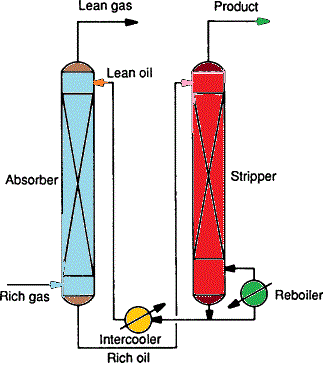The main difference between absorption and distillation is there. And selection criteria for solvent in gas absorption. While selecting a particular solvent for absorption operation the following properties of the solvent are considered.
{tocify} $title={Table of Contents}
Difference Between absorption and distillation
| Absorption | Distillation |
|---|---|
| Gas absorption is related to the separation of the constituents of a gas mixture. | Distillation is related to the separation of the constituents of a liquid mixture. |
| In gas absorption, the constituents of the gas mixture are separated by using a liquid solvent. | In distillation, the constituents of a liquid mixture are separated by using thermal energy. |
| The liquid solvent used in gas absorption is below its boiling point. | The liquid in the distillation operation is at its bubble point. |
| In gas absorption, a gas phase contacts a liquid phase and mass is transferred from the gas phase to the liquid phase transfer takes place in one direction. It is a case of steady-state diffusion of A through non-diffusing B (e.g. A is NH3 and B is air in absorption of NH3 from ammonia air mixture in water. | In distillation a vapour phase contacts a liquid phase and mass is transferred both from the liquid phase to the vapour phase and from the vapour phase to the liquid phase transfer takes place in both directions simultaneously. It is a case of steady-state equimolar counter diffusion. |
| Gas absorption does not give a pure product. It needs further processing for the recovery of the solute/solvent. | Distillation gives the almost pure product in a single processing step. |
| In gas absorption heat effects are attributed to the heat of the solution of the dissolved gas. | The liquid in the distillation operation is at its bubble point. |
| Packed towers are widely used for absorption operations. | Plate towers are widely used for distillation operations. |
| Differences in the solubility of gases in a selective solvent are exploited to affect the separation by absorption. | Differences in the volatility of constituents of a liquid mixture at the same temperature solution are exploited to affect the separation by distillation. |
| Example - the removal of SO2 from flue gases by alkaline solutions. | Example - separation of petroleum crude into gasoline, kerosene, fuel oil, etc. |
Selection criteria for solvent in gas absorption
While selecting a particular solvent for absorption operation the following properties of the solvent are considered.
(i) Gas solubility
The solubility of a solute gas in a solvent should be high, i. e. the solvent should have a high capacity for dissolving the desired solute gas so that a less amount of the solvent will be then required for a given absorption duty. In general, for good solubility, a solvent of a chemical nature similar to that of the solute to be absorbed must be searched out and used.
The solvent selected should have high solubility for the solute to be absorbed.
(ii) Volatility
As the gas leaving an absorption unit is generally saturated with the solvent there will be a loss of the solvent with the leaving the unit operation. Hence to minimize the solvent loss the solvent should be as far as possible less volatile, i.e. should have a low vapour pressure under the given operating conditions.
(iii) Corrosive nature
The solvent should not be corrosive to common materials of construction so that the construction materials for absorption equipment will not be too expensive.
(iv) Viscosity
The solvent should have low viscosity for rapid absorption rates, low pumping cost and better heat transfer. The solvent should be non-viscous.
(v) Cost and availability
The solvent should be cheap and readily available. Losses are less costly with cheap solvents.
(vi) Miscellaneous
The solvent should be non-toxic, non-flammable, non-foaming, and chemically stable from a handling and storage point of view.
>Steam Distillation process | Steam distillation of essential oils
>Packed Columns/Towers for Distillation and Gas Absorption
Take these Notes is, Orginal Sources: Unit Operations-II, KA Gavhane

